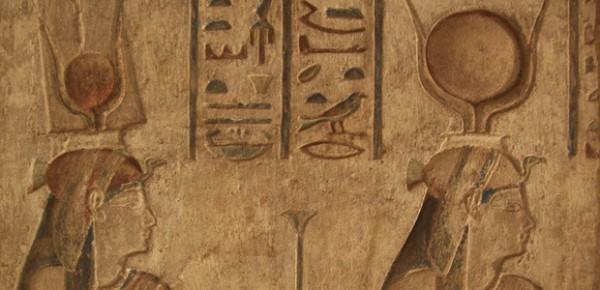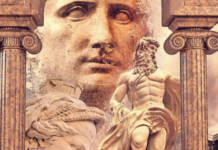 The decentralization and shifting of power from the Pharaohs to the common people in ancient Egypt came about during the period of Middle Kingdom (2050 – 1786 BCE). With the change of power or democratization, the common people, known as nomarchs, began to revise funerary spells of The Pyramid Texts (writings engraved in stone walls) that had existed from the preceding pharaoh-governed Old Kingdom.
The decentralization and shifting of power from the Pharaohs to the common people in ancient Egypt came about during the period of Middle Kingdom (2050 – 1786 BCE). With the change of power or democratization, the common people, known as nomarchs, began to revise funerary spells of The Pyramid Texts (writings engraved in stone walls) that had existed from the preceding pharaoh-governed Old Kingdom.
They then inscribed those modified funerary spells on and inside the coffins, known as The Egyptian Coffin Texts, and it is in the Coffin Texts where more extensive descriptions of the goddess Hathor were found. However, her family linage can be traced back in the Pyramid Texts of the pharaoh-governed Old Kingdom, specifically in the Fourth Dynasty, between 2613-2498 BCE.
In spell 405 of the Pyramid Texts, Hathor was described as the “Eye of Ra” or “Eye of the Sun.” Ra was the sun god in ancient Egypt, and as the Eye of Ra, Hathor has come to be known as the daughter of Ra, although some accounts suggest that Hathor was also the wife of Ra.
However in the Coffin Texts Hathor, as a deity, was more of a genesis than a derivative goddess. Nomarchs described her as “the Primeval, the Lady of all,” who was created even before the creation of the earth and the sky.
Funerary goddess and more
With the shifting of power, the intensity of desire among the nomarchs to live a worry-free eternal life did not change. Rather, it remained identical to that of the pharaohs. In the funerary inscriptions on the coffins, the nomarchs began to highlight Hathor’s importance as an intercessory or mediator of afterlife. In spell 295 of the Coffin Texts, Hathor is described as the creator and guardian of one of the gates to afterlife. Therefore, Hathor’s significance control over the destiny of the dead necessitated the living to keep her satisfied through worshipping, and therefore gain an effortless entry into the afterlife.
Had Hathor’s role been limited to playing an intercessor of the afterlife as described in the Coffin Text, she wouldn’t have evolved into one of the most important deities from ancient times. Because things got more puzzling as she, apart from playing her mortuary functions in the period of Middle Kingdom, played several seemingly incompatible roles before and after that era. The roles she played did not have a coherent sequence; therefore her deistic functions lack a clear pattern. As a result some degree of befuddlement is bound to emerge for anyone delving into studying this goddess. Even scholars and Egyptologists are not exempted from the confusion created by the many representations of Hathor. Important to note, no other deities in the Egyptian pantheon followed pattern as scrambled as that of Hathor.
Let’s look into some of Hathor’s most important representations.
Mother goddess
The origin of her most important moniker “mother goddess” is hidden in her very name Hathor, meaning “House of Horus.” “House” is to be taken as Hathor’s uterus where Horus, one of the earliest Egyptian male deities, was believed to have been born. If Hathor was the mother of Horus, she was also the mother of all pharaohs (hence the tag “mother goddess”), because Horus was believed to be incarnated in pharaohs.
Hathor is believed to be the earliest Egyptian mother goddess, and other subsequent mother goddesses, such as Isis and Nut, were based on her. Put simply, she was the forerunner of all important female deities in the Egyptian pantheon. According to R.T. Rundle Clark, the author of Myth and Symbol in Ancient Egypt, Hathor’s primary role as mother goddess was depreciated in The Pyramid Texts of the Old Kingdom, but was highlighted back in the Coffin Texts of the Middle Kingdom.
Sky and fertility goddess
Sometimes Hathor was represented as the sky goddess, and Horus was represented as the sun god. The phrase “House of Horus” can be applied to explain the relationship between these two representations: the sun (Horus) passes through its daily life cycle, from rising to setting, in the shelter (house) of the sky (Hathor). Aside from carrying out her maternal roles, as a devoted daughter of another sun god Ra, Hathor once took the form of a fearsome lioness, known as Sekhmet, and stopped the insurgence of Ra’s disciples on Earth.
However, Hathor was ubiquitously associated with cow. When not represented in full cow form, she was depicted as a woman with a cow’s head atop her torso. At other times, she had a woman’s body and face, and atop her head had a pair of outward-pointing horns encircling a scarlet sun disc. During the vernal and autumnal equinoxes, when day and night are of equal length, the sky above would perfectly align with the ground below. Ancient Egyptians believed the cow goddess Hathor supported the Milky Way with her four legs, and that her belly was studded with stars. Because of the Milky Way’s milky patch of the sky, the Egyptian would think of Hathor as a lactating cow that could produce a lot of milk, and associated her prolific feature with annual inundation of the Nile that deposited a lot of silt and made an otherwise desert region a fertile land.
Speaking of Hathor as cow, a close analogy exists between Hathor’s bovine personification and the second sign of zodiac, Taurus, which is associated with the bull. But if we replace the bull with Hathor’s cow, then Taureans’ personality traits match far better with some of Hathor’s representations: fertility, nurturing, birth, love, and joy.
The analogy is not a mere coincidence. As far back as early bronze age, the sun could be located in the constellation of Taurus during the spring equinox. During the rise of the Egyptian civilization, the Egyptians believed that the human race was born when the sun was in Taurus, and when the constellation lines were added in the sky, it looked quite like a bull by the naked eye.
Goddess of sensuality
One of the first descriptions of the creation of human race was found in spell 527 of The Pyramid Texts, which describes the god Atum, one of the earliest creator deities, who used either of his two hands to indulge himself in sexual pleasure (an obvious reference to masturbation), and created the humankind. Hathor was represented as Atum’s either of the two hands that he used to “copulate” with himself. She came to be known as the Hand of Atum.
Goddess of dance, music, and festivity
As mentioned earlier, Ra sent his daughter Hathor as lioness Sekhmet to quell the insurgence that had risen among his followers. But she soon became blood-thirsty and descended into a killing spree. Her frenzied slaying was dwindling the human race. Regretting his decision, Ra tricked his daughter into drinking alcoholic liquid, identical in colour to human blood. As she became drunk she forgot about the killing, and the rest of the mankind was saved.
To keep the deity’s destructive persona dormant, Hathor’s worshippers began to celebrate a festival, which came to be known as “The Drunkenness of Hathor,” by offering her wine and indulging themselves in dance and music.The bat-sistrum, an ancient Egyptian percussion instrument, considered sacred to Hathor by her cult, was played as many as three to four times a day to appease the deity. Music and dance became and integral part of Hathor worship ever since.
The Drunkenness of Hathor celebration would take place every year right before the Nile’s inundation of the land. Some scholars suggest that the worship was symbolic. They worshipped Hathor in that manner to make sure the great river’s flooding was productive, and not destructive like Sekhmet.
What makes Hathor different from other deities is the many roles she played as facilitator (of a happy eternal life), wife, mother, devoted daughter, lover, carer, symbol of sensuality and sexuality, and the connoisseur of dance and music.
A great way to align with her is through dance and music, as these were a large part of her worship. To invoke the goddess, any instrument that you love to play and music you love to listen would do the job, so long as the image of the goddess stays fresh in your heart and mind.
Image credit: Institute for the Study of the Ancient World








